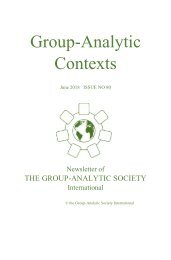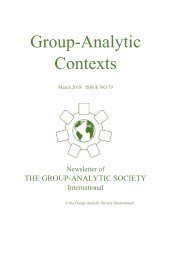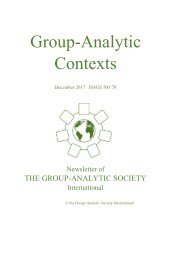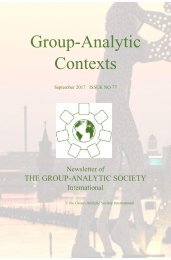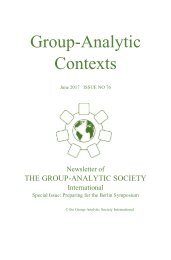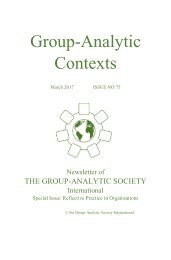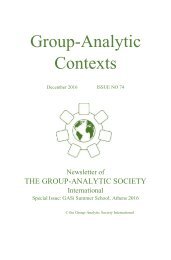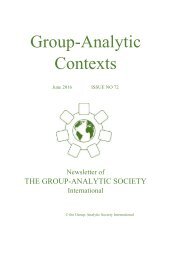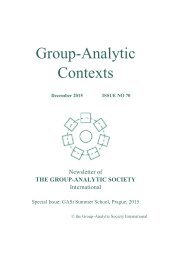Group-Analytic Contexts, Issue 81, September 2018
Newsletter of the Group Analytic Society International
Newsletter of the Group Analytic Society International
Create successful ePaper yourself
Turn your PDF publications into a flip-book with our unique Google optimized e-Paper software.
Newsletter – Autumn <strong>2018</strong> 21<br />
Refugees in the world could be thought of as people in a<br />
society in which mental diversity and different features are not<br />
accepted (Panagiotopoulou, 2017). Mrs A., a lady with mental health<br />
problems, writes: ‘…I always thought about my truth which people<br />
around me do not accept, none has ever accepted, has ever listened to<br />
my truth, to my desires, to my abilities…’.<br />
The ‘invisible refugee’ metaphorically means the group<br />
member that society does not regard as a refugee, but is a refugee in a<br />
dubious manner, socially and mentally. For example, the unemployed<br />
person, a refugee within society, unable to find his place in the job<br />
market, does not look like a refugee, so his despair is not recognized,<br />
he becomes invisible. The ‘black sheep’, a refugee within the family,<br />
is bearing the fear of failure for the whole family. A refugee in his<br />
mind is someone estranged from his internal sources who<br />
unconsciously vacates them (Biran, 2017).<br />
The mental patient considered as a refugee in society<br />
and in the world.<br />
According to Freud, ‘…this uncanny is in reality nothing new or alien,<br />
but something which is familiar and old-established in the mind and<br />
which has become alienated from it only through the process of<br />
repression’, that is ‘the uncanny (unheimlich) is what was once<br />
familiar’ (Freud, 1919). The menace in the foreigner and in the<br />
different other is about our relationship with the estrangement of our<br />
own unconscious. As Mitchell describes, “the first narcissism is a<br />
notional ‘at one-ness’ with its environment, uterine and then maternal.”<br />
(Mitchell, 2003). Lacan emphasizes ‘…the role of the brother, the role<br />
of the similar in our figuration as a subject’ (Lacan, 1938).<br />
Separation constitutes the beginning of the ego. ‘There is a<br />
need to die (symbolically) in relation to the Ego I represent and to<br />
recognize (internalize) the Other who has been an enemy so far’<br />
(Koukis, 2009). But, at the same time, it may imply the onset of<br />
psychosis. ‘The (family) organization that the subject meets and the<br />
reason which it listens to are what transform the space where the ego<br />
is impending to a space where paranoia impends… Madness expresses<br />
the extreme form of the only feasible refusal to the ego… The<br />
schizophrenic, as each subject, has met one out-of-itself according to<br />
the desires of the Other’ (Aulagnier, 1975).<br />
The Other, as a fellow-being and brother, represents the one<br />
who is identical to us and proclaims envy. ‘In the individual’s mental<br />
life, someone else is invariably involved, as a model, as an object, as<br />
a helper, as an opponent’ (Freud, 1921). We understand ourselves



